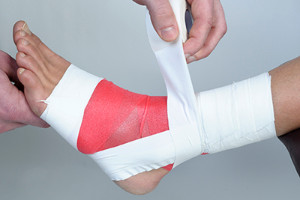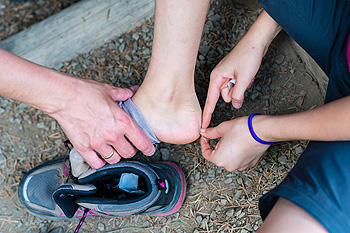Blog
Broncos QB Paxton Lynch Suffers High Ankle Sprain
 Denver Broncos quarterback Paxton Lynch will miss around two to four weeks due to a high ankle sprain. Lynch sustained the injury during the third quarter of the Oakland Raiders and Broncos game. He was seen wearing a boot on his right ankle when he was leaving on the team’s bus. Fellow teammate and backup quarterback Trevor Siemian will take his place. Unfortunately for Broncos fans, not only was Lynch injured, but the Broncos lost 21 to 14.
Denver Broncos quarterback Paxton Lynch will miss around two to four weeks due to a high ankle sprain. Lynch sustained the injury during the third quarter of the Oakland Raiders and Broncos game. He was seen wearing a boot on his right ankle when he was leaving on the team’s bus. Fellow teammate and backup quarterback Trevor Siemian will take his place. Unfortunately for Broncos fans, not only was Lynch injured, but the Broncos lost 21 to 14.
Ankle sprains are common but need immediate attention. If you need your feet checked, contact Genine Befumo, DPM from University Foot and Ankle Center, L.L.C. Our doctor can provide the care you need to keep you pain-free and on your feet.
How Does an Ankle Sprain Occur?
Ankle sprains take place when the ligaments in your ankle are torn or stretched beyond their limits. There are multiple ways that the ankle can become injured, including twisting or rolling over onto your ankle, putting undue stress on it, or causing trauma to the ankle itself.
What Are the Symptoms?
- Mild to moderate bruising
- Limited mobility
- Swelling
- Discoloration of the skin (depending on severity)
Preventing a Sprain
- Wearing appropriate shoes for the occasion
- Stretching before exercises and sports
- Knowing your limits
Treatment of a Sprain
Treatment of a sprain depends on the severity. Many times, people are told to rest and remain off their feet completely, while others are given an air cast. If the sprain is very severe, surgery may be required.
If you have suffered an ankle sprain previously, you may want to consider additional support such as a brace and regular exercises to strengthen the ankle.
If you have any questions please feel free to contact our office located in Monroe Township, NJ . We offer the newest diagnostic and treatment technologies for all your foot and ankle needs.
Broncos QB Paxton Lynch Suffers High Ankle Sprain
 Denver Broncos quarterback Paxton Lynch will miss around two to four weeks due to a high ankle sprain. Lynch sustained the injury during the third quarter of the Oakland Raiders and Broncos game. He was seen wearing a boot on his right ankle when he was leaving on the team’s bus. Fellow teammate and backup quarterback Trevor Siemian will take his place. Unfortunately for Broncos fans, not only was Lynch injured, but the Broncos lost 21 to 14.
Denver Broncos quarterback Paxton Lynch will miss around two to four weeks due to a high ankle sprain. Lynch sustained the injury during the third quarter of the Oakland Raiders and Broncos game. He was seen wearing a boot on his right ankle when he was leaving on the team’s bus. Fellow teammate and backup quarterback Trevor Siemian will take his place. Unfortunately for Broncos fans, not only was Lynch injured, but the Broncos lost 21 to 14.
Ankle sprains are common but need immediate attention. If you need your feet checked, contact one of our podiatrists from University Foot and Ankle Center, L.L.C. Our doctors can provide the care you need to keep you pain-free and on your feet.
How Does an Ankle Sprain Occur?
Ankle sprains take place when the ligaments in your ankle are torn or stretched beyond their limits. There are multiple ways that the ankle can become injured, including twisting or rolling over onto your ankle, putting undue stress on it, or causing trauma to the ankle itself.
What Are the Symptoms?
- Mild to moderate bruising
- Limited mobility
- Swelling
- Discoloration of the skin (depending on severity)
Preventing a Sprain
- Wearing appropriate shoes for the occasion
- Stretching before exercises and sports
- Knowing your limits
Treatment of a Sprain
Treatment of a sprain depends on the severity. Many times, people are told to rest and remain off their feet completely, while others are given an air cast. If the sprain is very severe, surgery may be required.
If you have suffered an ankle sprain previously, you may want to consider additional support such as a brace and regular exercises to strengthen the ankle.
If you have any questions please feel free to contact one of our offices located in East Brunswick and Monroe Township, NJ. We offer the newest diagnostic and treatment technologies for all your foot and ankle needs.
Read more about Ankle SprainsHeel Pain Can be Treated!
Treating and Preventing Cracked Heels
 Cracked heels are generally a minor and common – albeit discomforting – foot condition. The heels typically become cracked because of a lack of moisture. Therefore, it is important to moisturize your feet if they tend to become dry. Apply a moisturizer twice daily to help prevent the skin on the feet from becoming cracked. Washing your feet daily in a foot bath can help as well. It is important to keep the foot dry beyond moisturizing because bacteria and fungus thrive in wet and hot environments, like the feet. Wear socks that allow the feet to breath. Cotton socks are standard wear for most people and should be fine, but synthetic socks generally wick away moisture and allow for better air circulation. Similarly, shoes should be breathable as well.
Cracked heels are generally a minor and common – albeit discomforting – foot condition. The heels typically become cracked because of a lack of moisture. Therefore, it is important to moisturize your feet if they tend to become dry. Apply a moisturizer twice daily to help prevent the skin on the feet from becoming cracked. Washing your feet daily in a foot bath can help as well. It is important to keep the foot dry beyond moisturizing because bacteria and fungus thrive in wet and hot environments, like the feet. Wear socks that allow the feet to breath. Cotton socks are standard wear for most people and should be fine, but synthetic socks generally wick away moisture and allow for better air circulation. Similarly, shoes should be breathable as well.
Cracked heels are unsightly and can cause further damage to your shoes and feet. If you have any concerns, contact Genine Befumo, DPM from University Foot and Ankle Center, L.L.C. Our doctor can provide the care you need to keep you pain-free and on your feet.
Cracked Heels
Cracked heels appear unappealing and can make it harder for you walk around in sandals. Aside from looking unpleasant, cracked heels can also tear stockings, socks, and wear out your shoes. There are several methods to help restore a cracked heel and prevent further damage.
How Do You Get Them?
Dry skin is the number one culprit in creating cracked heels. Many athletes, walkers, joggers, and even swimmers suffer from cracked heels. Age and skin oil production play a role to getting cracked heels as well.
Promote Healing
Over the counter medicines can help, especially for those that need instant relief or who suffer from chronic dry feet.
Wear Socks – Wearing socks with medicated creams helps lock in moisture.
Moisturizers – Applying both day and night will help alleviate dryness which causes cracking.
Pumice Stones – These exfoliate and remove dead skin, which allows for smoother moisturizer application and better absorption into the skin.
Change in Diet
Eating healthy with a well-balanced diet will give the skin a fresh and radiant look. Your body responds to the kinds of food you ingest. Omega-3 fatty acids and zinc supplements can also revitalize skin tissue.
Most importantly, seek professional help if unsure how to proceed in treating cracked heels. A podiatrist will help you with any questions or information needed.
If you have any questions, please feel free to contact our office located in Monroe Township, NJ . We offer the newest diagnostic and treatment technologies for all your foot care needs.
Treating and Preventing Cracked Heels
 Cracked heels are generally a minor and common – albeit discomforting – foot condition. The heels typically become cracked because of a lack of moisture. Therefore, it is important to moisturize your feet if they tend to become dry. Apply a moisturizer twice daily to help prevent the skin on the feet from becoming cracked. Washing your feet daily in a foot bath can help as well. It is important to keep the foot dry beyond moisturizing because bacteria and fungus thrive in wet and hot environments, like the feet. Wear socks that allow the feet to breath. Cotton socks are standard wear for most people and should be fine, but synthetic socks generally wick away moisture and allow for better air circulation. Similarly, shoes should be breathable as well.
Cracked heels are generally a minor and common – albeit discomforting – foot condition. The heels typically become cracked because of a lack of moisture. Therefore, it is important to moisturize your feet if they tend to become dry. Apply a moisturizer twice daily to help prevent the skin on the feet from becoming cracked. Washing your feet daily in a foot bath can help as well. It is important to keep the foot dry beyond moisturizing because bacteria and fungus thrive in wet and hot environments, like the feet. Wear socks that allow the feet to breath. Cotton socks are standard wear for most people and should be fine, but synthetic socks generally wick away moisture and allow for better air circulation. Similarly, shoes should be breathable as well.
Cracked heels are unsightly and can cause further damage to your shoes and feet. If you have any concerns, contact one of our podiatrists from University Foot and Ankle Center, L.L.C. Our doctors can provide the care you need to keep you pain-free and on your feet.
Cracked Heels
Cracked heels appear unappealing and can make it harder for you walk around in sandals. Aside from looking unpleasant, cracked heels can also tear stockings, socks, and wear out your shoes. There are several methods to help restore a cracked heel and prevent further damage.
How Do You Get Them?
Dry skin is the number one culprit in creating cracked heels. Many athletes, walkers, joggers, and even swimmers suffer from cracked heels. Age and skin oil production play a role to getting cracked heels as well.
Promote Healing
Over the counter medicines can help, especially for those that need instant relief or who suffer from chronic dry feet.
Wear Socks – Wearing socks with medicated creams helps lock in moisture.
Moisturizers – Applying both day and night will help alleviate dryness which causes cracking.
Pumice Stones – These exfoliate and remove dead skin, which allows for smoother moisturizer application and better absorption into the skin.
Change in Diet
Eating healthy with a well-balanced diet will give the skin a fresh and radiant look. Your body responds to the kinds of food you ingest. Omega-3 fatty acids and zinc supplements can also revitalize skin tissue.
Most importantly, seek professional help if unsure how to proceed in treating cracked heels. A podiatrist will help you with any questions or information needed.
If you have any questions, please feel free to contact one of our offices located in East Brunswick and Monroe Township, NJ. We offer the newest diagnostic and treatment technologies for all your foot care needs.
Read more about Solutions for Cracked HeelsHow Blisters Can be Prevented
 When you increase the amount of friction on the foot, you also increase the risk of getting blisters. Blisters can originate from many sources, including socks, sweat, shoes and restricted foot motion. It’s important to have adequate toe room in the shoe; this can lessen friction, therefore preventing blisters. When proper insoles are worn, fewer blisters may occur. Additionally, wearing the correct socks, such as synthetic or wool socks, can be important in reducing skin friction. Sweat can also be a factor in producing blisters and typically happens in the warmer months. Using an antiperspirant may aid in producing less sweat, and fewer blisters may occur.
When you increase the amount of friction on the foot, you also increase the risk of getting blisters. Blisters can originate from many sources, including socks, sweat, shoes and restricted foot motion. It’s important to have adequate toe room in the shoe; this can lessen friction, therefore preventing blisters. When proper insoles are worn, fewer blisters may occur. Additionally, wearing the correct socks, such as synthetic or wool socks, can be important in reducing skin friction. Sweat can also be a factor in producing blisters and typically happens in the warmer months. Using an antiperspirant may aid in producing less sweat, and fewer blisters may occur.
Blisters are prone to making everyday activities extremely uncomfortable. If your feet are hurting, contact Genine Befumo, DPM of University Foot and Ankle Center, L.L.C. Our doctor can provide the care you need to keep you pain-free and on your feet.
Foot Blisters
Foot blisters develop as a result of constantly wearing tight or ill-fitting footwear. This happens due to the constant rubbing from the shoe, which can often lead to pain.
What Are Foot Blisters?
A foot blister is a small fluid-filled pocket that forms on the upper-most layer of the skin. Blisters are filled with clear fluid and can lead to blood drainage or pus if the area becomes infected.
How Do Blisters Form?
Blisters on the feet are often the result of constant friction of skin and material, usually by shoe rubbing. Walking in sandals, boots, or shoes that don’t fit properly for long periods of time can result in a blister. Having consistent foot moisture and humidity can easily lead to blister formation.
Prevention & Treatment
It is important to properly care for the affected area in order to prevent infection and ease the pain. Do not lance the blister and use a Band-Aid to provide pain relief. Also, be sure to keep your feet dry and wear proper fitting shoes. If you see blood or pus in a blister, seek assistance from a podiatrist.
If you have any questions, please feel free to contact our office located in Monroe Township, NJ . We offer the newest diagnostic and treatment technologies for all your foot care needs.
How Blisters Can be Prevented
 When you increase the amount of friction on the foot, you also increase the risk of getting blisters. Blisters can originate from many sources, including socks, sweat, shoes and restricted foot motion. It’s important to have adequate toe room in the shoe; this can lessen friction, therefore preventing blisters. When proper insoles are worn, fewer blisters may occur. Additionally, wearing the correct socks, such as synthetic or wool socks, can be important in reducing skin friction. Sweat can also be a factor in producing blisters and typically happens in the warmer months. Using an antiperspirant may aid in producing less sweat, and fewer blisters may occur.
When you increase the amount of friction on the foot, you also increase the risk of getting blisters. Blisters can originate from many sources, including socks, sweat, shoes and restricted foot motion. It’s important to have adequate toe room in the shoe; this can lessen friction, therefore preventing blisters. When proper insoles are worn, fewer blisters may occur. Additionally, wearing the correct socks, such as synthetic or wool socks, can be important in reducing skin friction. Sweat can also be a factor in producing blisters and typically happens in the warmer months. Using an antiperspirant may aid in producing less sweat, and fewer blisters may occur.
Blisters are prone to making everyday activities extremely uncomfortable. If your feet are hurting, contact one of our podiatrists of University Foot and Ankle Center, L.L.C. Our doctors can provide the care you need to keep you pain-free and on your feet.
Foot Blisters
Foot blisters develop as a result of constantly wearing tight or ill-fitting footwear. This happens due to the constant rubbing from the shoe, which can often lead to pain.
What Are Foot Blisters?
A foot blister is a small fluid-filled pocket that forms on the upper-most layer of the skin. Blisters are filled with clear fluid and can lead to blood drainage or pus if the area becomes infected.
How Do Blisters Form?
Blisters on the feet are often the result of constant friction of skin and material, usually by shoe rubbing. Walking in sandals, boots, or shoes that don’t fit properly for long periods of time can result in a blister. Having consistent foot moisture and humidity can easily lead to blister formation.
Prevention & Treatment
It is important to properly care for the affected area in order to prevent infection and ease the pain. Do not lance the blister and use a Band-Aid to provide pain relief. Also, be sure to keep your feet dry and wear proper fitting shoes. If you see blood or pus in a blister, seek assistance from a podiatrist.
If you have any questions, please feel free to contact one of our offices located in East Brunswick and Monroe Township, NJ. We offer the newest diagnostic and treatment technologies for all your foot care needs.
Read more about Blisters on the FeetBlog Archives
- April 2024
- March 2024
- February 2024
- January 2024
- December 2023
- November 2023
- October 2023
- September 2023
- August 2023
- July 2023
- June 2023
- May 2023
- April 2023
- March 2023
- February 2023
- January 2023
- December 2022
- November 2022
- October 2022
- September 2022
- August 2022
- July 2022
- June 2022
- May 2022
- April 2022
- March 2022
- February 2022
- January 2022
- December 2021
- November 2021
- October 2021
- September 2021
- August 2021
- July 2021
- June 2021
- May 2021
- April 2021
- March 2021
- February 2021
- January 2021
- December 2020
- November 2020
- October 2020
- September 2020
- August 2020
- July 2020
- June 2020
- May 2020
- April 2020
- March 2020
- February 2020
- January 2020
- December 2019
- November 2019
- October 2019
- September 2019
- August 2019
- July 2019
- June 2019
- May 2019
- April 2019
- March 2019
- February 2019
- January 2019
- December 2018
- November 2018
- October 2018
- September 2018
- August 2018
- July 2018
- June 2018
- May 2018
- April 2018
- March 2018
- February 2018
- January 2018
- December 2017
- November 2017
- October 2017
- September 2017
- August 2017
- July 2017
- June 2017
- May 2017
- April 2017
- March 2017
- February 2017
- January 2017
- December 2016
- November 2016
- October 2016
- September 2016
- August 2016
- July 2016
- June 2016
- May 2016
- April 2016
- March 2016
- February 2016
- January 2016
- December 2015
- November 2015
- October 2015
- September 2015
- August 2015
- July 2015
- June 2015
- May 2015
- April 2015
- March 2015
- February 2015
- January 2015
- December 2014
- November 2014
- October 2014
- September 2014
- August 2014
- July 2014








